Because the L6/ Bainite is a real high-end sword from Hanwei I thought maybe it is time to spend some time on writing about it to get some more insight in this steel quality.
Basicly Davenport and Bain discovered in 1920’s this new steel microstructure and they gave it a name: marensive-troostite, due to it being intermediate between the already known low-temperature martensite phase and what was then known as troostite (now fine-pearlite).
Bain’s colleagues at the United States Steel Corporation called it Bainite and the scientific community took up this name in 1947. They also discovered the two distinct forms upper- and lower range bainite.
Hanwei took over those theories and so they have not to learn it from anybody. Paul Chen cum suis just put the theory into practice and experiment with the materials until they had perfected the process. They blades at Hanwei are made from genuine L6 tool steel and the blades are forged and shaped in the normal way, then carefully heat treated to achieve the required Bainite and Martensite structures before final polishing. Rough billet shaping is done with an air hammer but the blade is held in the hands of the smith at all times. The blade is not folded during forging. Both the blade and edge will need to be tempered after quenching. Hanwei’s tempers the blade in 300 c for 2 hours and tempers the edge in 200 c for 2 hours. They quench the blade in nitrate and quench the edge in oil. The acid used in the baths is sulphuric acid to make the hamon more visible.
Geometry adjustments, basic shaping and rough polishing is done with various types of grinding, sanding and polishing machines but at all times the blade is held in the hand. The grinding and polishing machines are fairly basic items that sit on benches, like those we might have in our own workshops at home, and are not huge industrial machines. The blade is always held in the hand during the whole grinding and polishing process and at no point is it fed into a machine or fixed into a machine. No CNC machinery is used. Final polishing is done by hand using both modern ‘sand’ papers and traditional stones.
So finally Bainite is a structure of high-carbon steel that combines great strength with excellent flexibility and shock absorption characteristics. It has been known as an exemplary Katana blade component for a number of years but its use has been restricted to a few top-class master smiths, due to the difficulties involved in performing the exacting heat treatment procedures necessary for the production of a Bainite blade body in combination with the very hard Martensite Yakiba (edge section) required for Katana blades.
In this steel quality they have made two katana’s the Praying Mantis katana and the Oni Katana.
The praying mantis katana is made in Shobu Zukuri Style, it is very nice and this style has no yokote line (a line vertically from the edge of the sword to define the tip of the sword). The tsuba, fuchi and kashira shows a praying mantis, which is a symbol of cunning and power in Japanese culture and is consequently a highly respected theme in Samurai swords. The katana has a Bo-Hi and makes this katana much lighter so easier to handle. So off course also it is a real cutter. Personally I like a lot the contrast between the dark copper and golden accents. The proportion is more standard 29/11 compared to the Oni Katana 29/14. The Sword Weight: 1.130 grams and has a Chu-Kissaki. The ito is green silk and the length of Blade is 73,6.6 cm
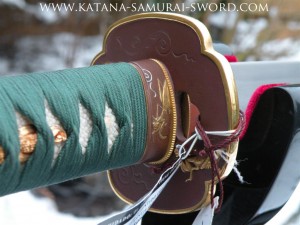
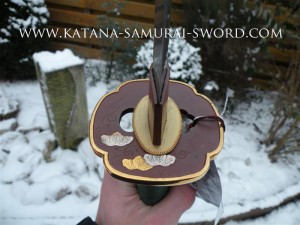
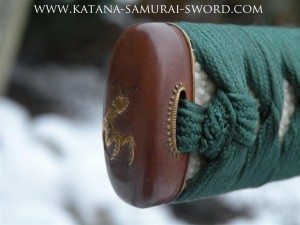
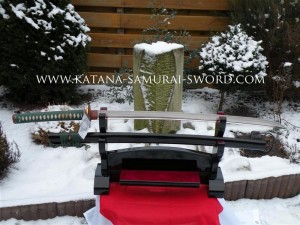
The Oni Katana are mythical creatures from Japanese folklore similar to western demons or trolls. In modern culture they are beginning to move away from this menacing connotation into the role of guardian or protector, similar in character to gargoyles. Their power and ferocity, however, have not diminished. There is a Japanese saying which translates to “Oni with an iron club”, or to be of an invincible nature, a fitting association with the 29” L6/Bainite blade on which our Oni Katana is built. The blade features the geometry of our Performance Series for outstanding cutting ability. The 14” tsuka is wrapped in black ray skin and silk ito while the Koshirae feature Oni in various classical styles. A unique combination of folklore and functionality. The Tsuka is little long in my opinion and has no Hi. The katana is an extremely cutter and looks pretty nice. This katana is a bit heavy in my view. The Oni has Yokote and the Tsuka is little fatter than the Mantis. Both the katana’s has a nice and prominent Hamon. The Sword Geometry is Shinogi-Zukuri and has a Chu-Kissaki. The sword weight is +/- 1.275 grams and the Ito is black Silk. The length of Blade is 73,66 cm. BTW in movie I mentioned forge-folded that is not correct!
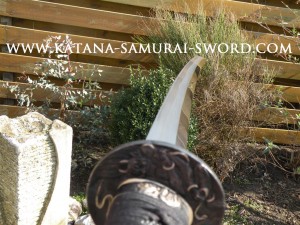
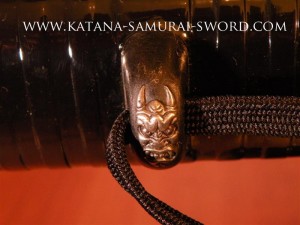
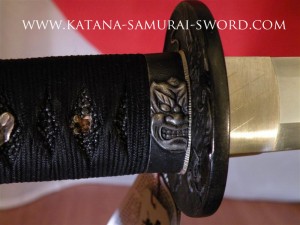
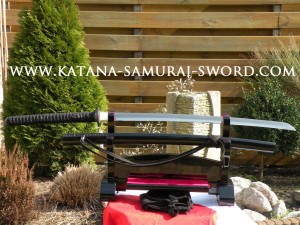
Good luck finding a good katana!
Jordy Klaver
www.katana-samurai-sword.com
